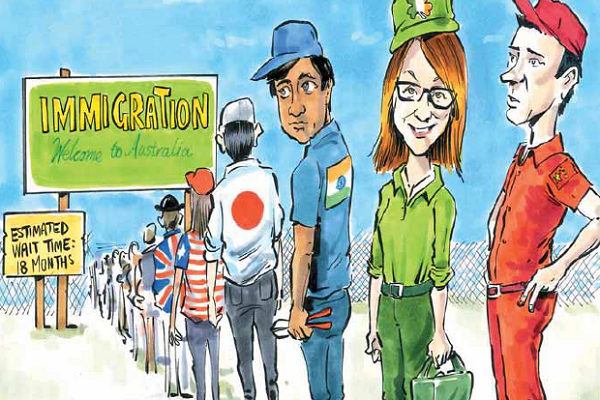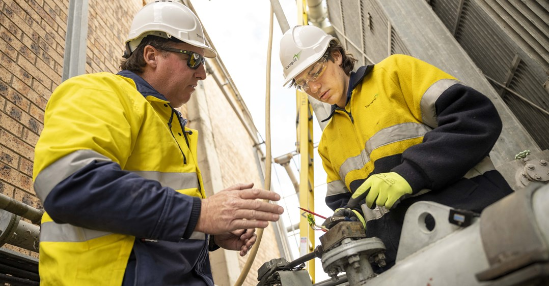Of the many troubling economic issues facing the Australian economic landscape, the increasing skills gap remains one of Australia's most significant and urgent issues.
How do we balance nurturing homegrown talent and importing much-needed expertise into Australia's labour force? Scott Morrison, our former Prime Minister, posed this question as one of the most significant challenges to our economy back in April of the previous year, emphasising the urgent need for skill development to maintain our global competitiveness.
The task of addressing Australia's skills gap isn't as simple as it once was. We can't patch it up with stopgap solutions anymore. Instead, what we're looking at here is a need for well-thought-out strategies that take into account not only current realities but also future needs.
Some might argue that our recent global isolation presents an opportunity to focus solely on reviving our domestic industries and capabilities. However, just as the pandemic exposed the short-sightedness of relying heavily on affordable immigration solutions, this inward-focused approach also has its own set of limitations.
As Treasurer Jim Chalmers pointed out in one of his early ma
jor interviews, Australia needs to invest strategically in local training while simultaneously seeking high-quality foreign skills to fill crucial gaps.
Balance is Key
Our end goal isn't simply about plugging immediate labor shortages. We're aiming for something more profound: creating an environment where migration and upskilling effectively complement each other. This balance could open doors across Australia's diverse industries and foster a culture of innovation, encouraging both domestic growth and international collaboration.
Current State of Australia's Skill Gap and Government Initiatives
Australia is currently facing a significant problem: the skill gap that is holding back various industries from reaching their full potential. This isn't just a theoretical issue – it's a real obstacle that is impacting sectors like healthcare, engineering, IT, and trades such as carpentry and plumbing. Despite having a strong economy, Australia is experiencing a shortage of workers in key areas, which could hinder future growth.
Industries Affected by Skill Shortages:
Healthcare: Australia's aging population has driven a high demand for healthcare professionals, including nurses, doctors, and aged care workers.
Information Technology: With the rapid integration of technology across sectors, skills in data analysis, coding, and digitial platforms are highly sought after.
Trades: Skilled trades such as electricians, plumbers, and construction workers remain in demand to support infrastructure and development projects.
Engineering: Engineers play a crucial role in innovation and progress, but there is a high demand for them and not enough supply.
The government has recognized this urgent issue and has implemented specific strategies to address it. They have made adjustments to the number of skilled migrants allowed into the country in order to fill the gaps with international talent. At the same time, they are investing in education and training programs to develop a skilled workforce within Australia.
But are these efforts effective? Let's take a closer look:
The Role of Skilled Migrants and Domestic Talent in Addressing Australia's Skill Gap
Understanding the Skill Gap
When we talk about Australia's skill gap, we're referring to the difference between the skills that employers need and the skills that the current labor force has. Why does this matter for Australia? Quite simply, it's about making sure the economy grows, encouraging new ideas, and helping workers find jobs.
Skilled Migration: A Double-Edged Sword
Skilled migrants bring a unique mix of knowledge and international experience to the Australian workforce. They help with immediate skill shortages, contribute to economic growth, and even create new jobs. For example, as of 2022, migrants hold a huge 26.3% of all jobs in Australia.
However, relying too much on skilled migration has its problems. Visa and immigration laws can make it hard to bring skilled workers into the country. And once they're here, things like language differences and recognising foreign qualifications can stop them from fully taking part in the workforce.

Upskilling Domestic Talent: An Investment for the Future
On the other hand, focusing on domestic talent means putting time and money into training programs to fill the skill gap from within. This doesn't just guarantee there are enough qualified people for job openings but also makes sure their skills match what employers need.
Let's look at the construction industry as an example. Even though there's a big skill gap, targeted training programs for local workers have been more successful than bringing in skilled migrants when it comes to meeting industry needs.
But upskilling domestic talent isn't easy either. Limited money and fast changes in technology mean education has to quickly adapt to what jobs require.
Real-Life Success Stories
Even with these challenges, there are great examples of how both skilled migrants and upskilled local workers have made a big difference to Australia's economy.
A study by PwC Australia showed how skilled migration helps the economy grow in the long run by encouraging research and new ideas. Similarly, programs like Canada's Express Entry have proven how carefully choosing skilled migrants can lead to more innovation and better productivity in the economy.
On the local side, more money for apprenticeship programs and lifelong learning initiatives have given Australian workers the power to learn new skills and take on jobs that are in demand. This doesn't just give them better career options but also reduces how much Australia relies on talent from other countries.
As we deal with these complexities, one thing becomes clear: solving Australia's skill gap isn't something that can be done in a simple way. It needs us to really understand both skilled migration and upskilling plans, what they offer, and what problems they bring.

Advantages & Challenges of Using Skilled Migration to Address Skill Shortages
Advantages of Using Skilled Migrants
Here are the advantages of using skilled migrants to address skill shortages in Australia:
Human Capital Boost: Skilled migrants increase the human capital stock, leading to improved returns on capital investments.
Innovation & Economic Growth: High-skilled immigrants can spur research and innovation, contributing to long-term economic growth.
Industrial Competitiveness & Job Retention: Skilled migrants can enhance industrial competitiveness and job retention, particularly in sectors experiencing local skill shortages.
Widening the Tax Base: Skilled migrants, who are typically more active in the labour market, can help widen the tax base and offset fiscal challenges.
Challenges of Employing Skilled Migrants
However, employing skilled migrants isn't a silver bullet. There are inherent challenges and issues that need thoughtful consideration:
Recognition of Foreign Qualifications: Migrants often face difficulties in having their qualifications recognised, leading to underemployment or unemployment.
Language Proficiency Requirements: Non-native speakers may struggle with language requirements, impacting their ability to secure suitable employment.
Integration Challenges: Migrants may encounter social, cultural or economic barriers upon their arrival in Australia.

Key Areas for Priority
Identifying key areas where migration policies and visas should be prioritized is crucial. Industries such as Information Technology (IT), Healthcare, Education and Engineering consistently appear on Australia's Skilled Occupation List (SOL) due to persistent skill shortages. Policymakers should prioritise these sectors when shaping skilled migration policies.
Proposed Measures for Improvement
Taking into account future skill demands as well as current challenges faced by the skilled migration program, several measures could be proposed:
Migration Policies Revision: There's a need for continuous review of migration policies to ensure they align with changing industry needs.
Increased Permanent Migration Intake: Raising the cap on permanent migrant intake would allow for a steady supply of skilled labour in high-demand sectors.
Reducing Regulatory Red Tape: Streamlining visa processing times and reducing bureaucratic hurdles would make Australia an attractive destination for skilled migrants.
Integration Strategies: Implementing programs that support cultural, social and economic integration can help migrants adapt faster, leading to better employment outcomes.
The Complexity of Skilled Migration
The conversation around skilled migration is complex. Yes, it offers solutions to immediate skill shortages and contributes to economic growth. At the same time, it's a delicate balance to ensure domestic talent isn't overlooked and that migrants are provided with fair opportunities. But let's not view this as an either-or debate. Rather, it's about finding common ground and leveraging the best of both worlds.
Advantages & Challenges of Upskilling Domestic Talent to Address Skill Shortages
Upskilling domestic talent is an important strategy for closing the skill gap. Why? Because it reduces dependence on foreign workers and ensures a steady supply of skilled labor within Australia. It's about giving Australian residents the tools they need to succeed in their jobs. And let's not forget, when we upskill someone today, they become an asset to our economy tomorrow. But why is upskilling so important? The reasons are clear:

Career Growth and Job Satisfaction: Upskilling initiatives create opportunities for employees to advance in their careers, leading to greater job satisfaction and higher retention rates.
Increased Productivity: When workers have the right skills for their roles, they can perform their tasks more efficiently, resulting in higher productivity levels.
Adaptive Workforce: By aligning skills training with industry needs, Australia ensures that its workforce remains adaptable and responsive to the changing demands of the global economy. It is a strategic approach that enhances the employability of graduates, reduces skill shortages, and fosters innovation.
Fostering Innovation and Economic Growth: As industries witness an influx of skilled and innovative professionals, they are better positioned to develop cutting-edge products and services, which, in turn, stimulate economic growth. The resultant economic vibrancy creates a fertile ground for further innovation and opportunity, completing a circle of prosperity.
However, investing in domestic talent also comes with its own set of challenges:
Mismatch between Training and Industry Needs: Often, education and training programs fail to align with the practical requirements of specific industries.
Financial Constraints: Upskilling initiatives require significant investment, both from individuals and organizations.
Keeping Up with Technological Advances: As technology continues to evolve rapidly, ensuring that workers' skills remain up-to-date can be a difficult task
Strategies to Overcome Challenges
So how can we overcome these challenges and successfully upskill our domestic workforce? Here are a few suggestions:
Apprenticeship Programs: By combining on-the-job training with classroom instruction, apprenticeship programs provide individuals with practical skills that are directly applicable to their field of work.
Funding for Further Education: Governments and organizations should collaborate to offer financial assistance for further education, making it more accessible to all.
Promotion of Lifelong Learning Culture: Encourage a mindset where learning doesn't end with formal education but continues throughout one's career.
By addressing the skill shortages through a combination of skilled migration and domestic upskilling, we can create a strong workforce that's prepared to face future challenges with confidence.
Finding Common Ground: A Balanced Approach to Solving Australia's Skill Gap
Let's move away from thinking that skilled migrants and upskilled domestic talent are always in opposition. Is it possible that both can work together for the greater good, each bringing their own strengths to address the skill gap in Australia?
It might be time to change how we see the problem. Instead of treating skilled migration and upskilling as competing options, let's view them as complementary parts of a strong and comprehensive strategy to solve Australia’s skill gap. They have their pros and cons, but combined, they could offer a more complete solution.

Exploring New Possibilities
Our future economic and social prosperity depends on our ability to create new industries and employment sectors. These new industries will require educated and skilled workforces that, in the short term to medium term at least, we cannot meet from onshore supply alone. In some key professions, we simply cannot meet the skills demand from domestic student demand alone.
Skilled migration must complement domestic skills and education, focusing on the quality of skills and qualifications and matching the nation's actual needs. That focus on quality, not quantity, is necessary for a system to complement domestic education, skills and training, emphasizing outcomes across the Australian community.
We cannot return to conditions pre-COVID, where international education faced real community concerns over quality and benefit. But just as truly, if we adopt a restricted border mentality, we stand no chance of attracting the talent we need, the skills gap will grow ever wider, and our global competitiveness will wane.
The Need for Collaboration
The solution to all this lies with the triangular powerhouse: education providers, including universities, TAFE and VET, working in partnership with state and federal governments and industry.
Each sector has a vital role to play – from skills and policy settings to meaningful, rewarding careers, as well as a responsibility to deliver. From opportunities to outcomes, we must all play our role and be accountable for it.
Together, we need to work more effectively with industry to map education and skills gaps and match to courses and graduates – both domestic and skilled migration. This is not about complex and long-term workforce modelling but a highly responsive system that looks at short, medium and longer-term interventions to support our communities and the economy.
Specifically, a funding and policy mechanism that is rapidly responsive to shifts in need and flexible to differing community shortages and opportunities across a working lifetime, not just immediate post-18 qualifications. We need a national education and skills approach that systematically links universities, TAFE, VET sector and skilled migration to best meet the nation’s needs as a whole.

